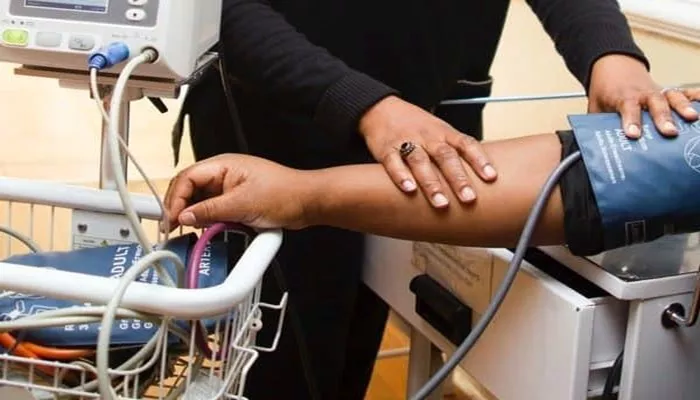Orthostatic hypotension is a form of low blood pressure. It occurs when a person stands up from sitting or lying down. The sudden drop in blood pressure may lead to dizziness, lightheadedness, or even fainting.
How It Is Defined Clinically
Orthostatic hypotension is defined by a drop of 20 mmHg in systolic blood pressure or 10 mmHg in diastolic blood pressure within three minutes of standing. These values are widely accepted in medical literature.
Why Checking for Orthostatic Hypotension Matters
Impacts on Patient Safety
This condition increases fall risk, particularly in older adults. It can also indicate underlying autonomic dysfunction or cardiovascular issues. Early detection is vital to reduce complications.
Associated Medical Conditions
It is often associated with diabetes, Parkinson’s disease, dehydration, and heart failure. Identifying orthostatic hypotension may help uncover these conditions early.
When to Check for Orthostatic Hypotension
Routine Check in the Elderly
Elderly patients should be screened regularly. Aging increases the risk of autonomic dysfunction and medication side effects that contribute to blood pressure drops.
In Cases of Unexplained Dizziness or Falls
Check for orthostatic hypotension when patients complain of dizziness upon standing or if they have experienced recent unexplained falls.
After Medication Changes
Medications that affect blood pressure or heart rate—like diuretics, beta-blockers, or antidepressants—may lead to orthostatic hypotension. Always monitor patients after dose changes or new prescriptions.
During Diabetic Autonomic Testing
People with diabetes are prone to autonomic neuropathy. Testing for orthostatic hypotension is standard when screening for diabetic complications.
Post-Dehydration or Blood Loss Events
Significant fluid loss can impair blood pressure regulation. Rehydration may resolve symptoms, but testing helps guide clinical decisions.
Neurological Symptoms Evaluation
Patients with symptoms like fatigue, blurred vision, or cognitive slowing might benefit from orthostatic testing to rule out hypotension-related causes.
How to Check for Orthostatic Hypotension
Standard Procedure for Measurement
- Have the patient lie down for 5 minutes
- Measure and record blood pressure and heart rate
- Have the patient stand up
- Measure blood pressure and heart rate at 1 and 3 minutes post-standing
- Monitor for symptoms like dizziness or nausea
Use of Tilt Table Testing
For complex cases or when symptoms are inconsistent, tilt table testing provides more detailed assessment. It involves controlled positional changes while monitoring cardiovascular responses.
24-Hour Ambulatory Monitoring
Ambulatory blood pressure monitoring may help detect intermittent or delayed orthostatic drops that are not evident in clinical settings.
Common Symptoms to Watch For
Physical Manifestations
- Lightheadedness
- Dizziness
- Fainting (syncope)
- Blurred vision
- Weakness or fatigue
Behavioral Clues
- Avoidance of standing or walking
- Slow movement transitions
- Expressed fear of falling
Recurrent Fall Injuries
Patients with frequent unexplained injuries or bruises should be assessed for orthostatic hypotension.
Causes of Orthostatic Hypotension
Volume Depletion
Causes include bleeding, dehydration, or diuretic use. These lead to reduced circulating volume and impaired blood pressure regulation.
Autonomic Dysfunction
Conditions like Parkinson’s disease or multiple system atrophy affect autonomic control of blood pressure, leading to inadequate compensation upon standing.
Cardiac Causes
Heart failure, arrhythmias, and myocardial infarction can contribute to orthostatic symptoms by reducing cardiac output.
Endocrine Causes
Adrenal insufficiency, hypothyroidism, and diabetic neuropathy can interfere with blood pressure regulation.
Medication-Induced
Common drugs causing this include:
- Antihypertensives
- Nitrates
- Antidepressants
- Antipsychotics
Treatment and Management Strategies
Lifestyle and Behavioral Changes
- Encourage slow position changes
- Increase salt intake (if appropriate)
- Elevate head of bed
- Wear compression stockings
Pharmacological Treatments
Medications may be needed in persistent or severe cases:
- Fludrocortisone to increase volume retention
- Midodrine to raise vascular tone
- Droxidopa for neurogenic hypotension
Treating Underlying Causes
Manage root problems like anemia, heart failure, or diabetic neuropathy to alleviate orthostatic symptoms effectively.
Monitoring and Follow-Up
Scheduled Reassessment
Periodic testing is necessary to track changes. Monitor especially after medication adjustments or new symptoms.
Patient Education
Educate patients on recognizing symptoms. Instruct them on safe movement techniques and when to seek help.
Conclusion
Orthostatic hypotension is a clinically significant condition. Timely detection and proper testing are critical. Always consider the patient’s full medical context when deciding to test. Management includes lifestyle changes, medication, and addressing underlying causes. Proper education and follow-up can improve outcomes and prevent serious complications like falls or syncope.
Related topics:


